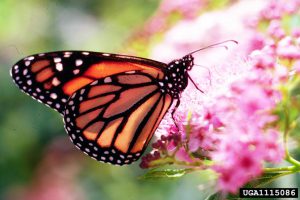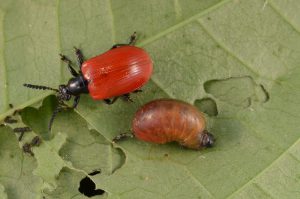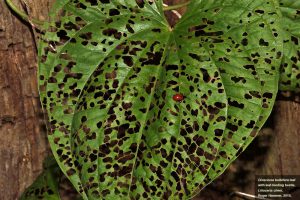This is a post by UF/IFAS Entomology and Nematology graduate student, Patricia Prade, Dr. Carey Minteer, and Dr. Adam Dale.
Have you ever asked yourself why there are so many invasive plant species around if we have so many plant feeding insects? Why do pest insects eat our lawn and garden plants and not the weeds or invasive plants that we want to get rid of? Can we somehow teach these insects to change their diet preferences? Unfortunately, the answer is not that simple…
Plants are not mobile but they have several ways to defend themselves from things that try to eat them. For example, some plants produce toxic chemicals that can slow or kill herbivores, while others have thorns, hairs, or thick leaves that physically keep things from consuming them.


Despite these fierce and complex defenses, some insects have figured out ways around them. A well-known example of this is the monarch butterfly. Monarch caterpillars feed on milkweed, a group of plants filled with a toxic latex that kills or deters insects that feed on it. However, monarch caterpillars have adapted some strategies to get around this plant defense. When feeding, the caterpillars cut the leaf veins close to the feeding site so the latex cannot reach them. Even more impressively, monarchs also store (sequester) that toxic latex in their body and use it as their own defense against predators. In result, monarchs are one of the few organisms that can feed on milkweed species.
Many insects native to the U.S. feed only on one plant species or closely related group of plants. Just like people, insects need a balanced diet with nutrients required to help them grow and reproduce. Introduced or exotic plant species often do not have the nutrients native insects need. In addition, exotic plant defenses are often novel compared to native plant defenses that local insects are familiar with. For example, exotic plants may have chemical defenses that native insects have never been exposed to. In result, native insects often cannot feed on or digest exotic plant tissues.
Native plant species and their herbivores tend to naturally regulate each other’s populations. However, many exotic invasive plants grow and reproduce free of this herbivore regulation, explaining why some invasive species take over large areas so quickly.
When invasive species are widespread, one option for their control is a classical biological control program. Classical biological control is the reunion of an exotic plant species with the herbivore(s) from the plant’s native range in its invaded range. This is typically slow and requires a lot of investment upfront involving research and regulatory agencies. However, economic analyses have shown that the cost: benefit ratio of biological control versus chemical control can be 145:1.


In Florida, there are several examples of successful classical biological control programs (invasive mole crickets, tropical soda apple). Most recently, the air potato leaf beetle was introduced to control invasive air potato vines. For many years, air potato has been a big problem in Florida because it outcompetes native vegetation for light and nutrients. However, air potato beetles have been released into Florida’s landscapes and the problems with air potato are much smaller. Habitats that were once covered with air potato are recovering.
Insects live to reproduce. Therefore, they must be picky eaters to ensure they consume what they need to succeed. We can’t teach them to eat undesirable plants but we can sometimes bring in insects that will. For more information on biological control of invasive plants at the University of Florida, check out Dr. Carey Minteer’s or Dr. Jim Cuda’s labs in IFAS.
 2
2
